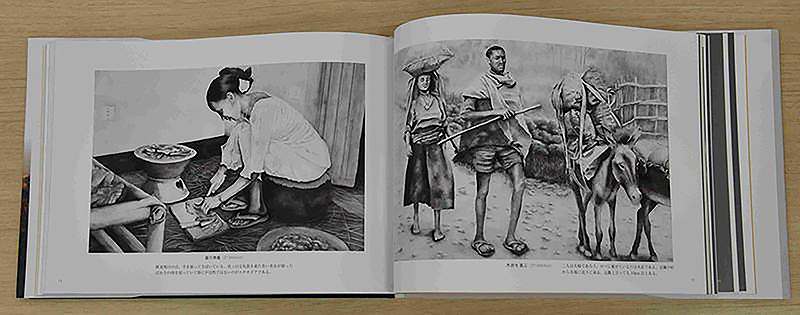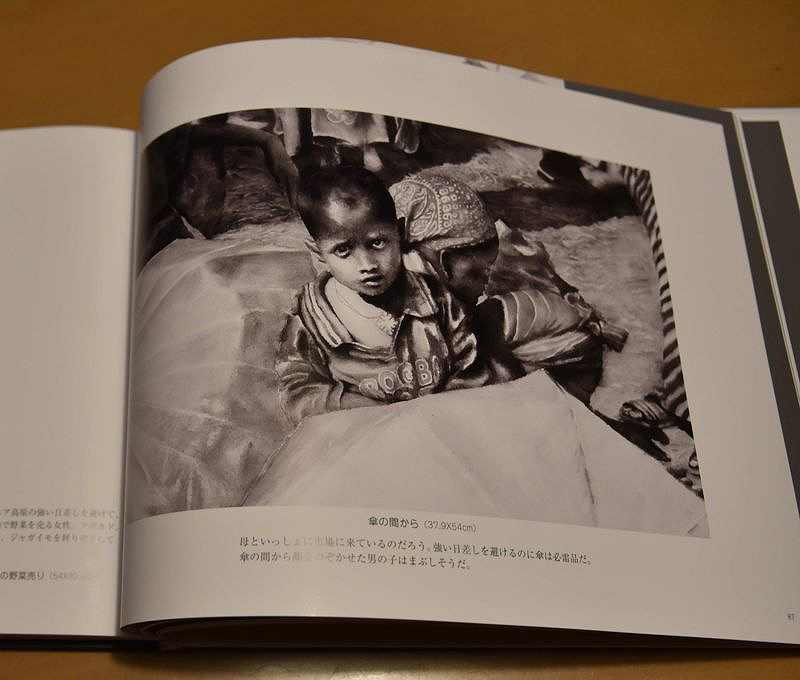
Ink paintings depicting daily life in northern Ethiopia from Nobuyuki Matsubayashi’s self-published book “Ethiopia ni Ikiru (Living in Ethiopia)”
November 11, 2021
A girl carrying a large water container on her back, a boy chasing a herd of cattle, a family dressed in white traditional attire heading to an Ethiopian Orthodox church.
Such are the scenes of daily life in northern Ethiopia captured in a collection of about 130 ink paintings in a newly self-published book titled “Ethiopia ni ikiru (Living in Ethiopia)” by a Mie Prefecture pediatrician who spent two years in the country.
The 73-year-old pediatrician, Nobuyuki Matsubayashi, worked in Ethiopia’s northern region of Amhara as a medical specialist dispatched by the Japan International Cooperation Agency from 2010 to 2012. During the posting, he started painting the daily lives of local people and has continued to create his art after returning to Japan, based on photographs he took in Ethiopia.

“I was enchanted by Ethiopian people’s facial expressions that showed their inner strength,” Matsubayashi said.
He was based in Amhara’s regional capital Bahir Dar — a highland city of an altitude of about 1,800 meters that developed around Lake Tana, which is said to be the source of the Blue Nile. But outside the city limits stretches arid land, and the region has long been affected by civil war and border conflicts with Eritrea.
“Growing up in a harsh environment, even children had looks on their faces that were not just innocent but also tough,” he said.
Recently, the region has been engulfed in yet another conflict.

An ink painting depicting daily life in northern Ethiopia from Nobuyuki Matsubayashi’s self-published book “Ethiopia ni Ikiru (Living in Ethiopia)”
But at the time of the doctor’s sojourn, peace had been trickling back through the volatile region, nourishing rapid development and modernization.
“Long abandoned roadside tanks were being cleared, and mobile phones were spreading swiftly. It was a time of change,” Matsubayashi recalled. “I felt the urge to capture and preserve the beauty of Ethiopian traditional life that could soon be lost.”
At first, he casually sketched portraits of his local colleagues on the back of copy paper at the office during breaks — a pastime which quickly rekindled a passion for art from his student days.
Matsubayashi had been an enthusiastic member of an art club at the Kyoto University’s Faculty of Science, around the time of the student movement in the 1960s. After graduation, he backpacked through Europe, traveling up from Africa all the way to Asia. He fell ill in India, which led him to aspire to become a doctor.
He enrolled in Mie University’s Faculty of Medicine and became a doctor when he was almost 40 years old. Apart from his medical practice in Mie, he would go on to participate in two JICA projects and spend a total of eight years in Zambia and Tanzania before moving to Ethiopia.

Nobuyuki Matsubayashi visits a local health office in Ethiopia’s northern region of Amhara in 2011.
Matsubayashi took his oil painting tools to his first two postings to Africa, but did not have time to use them. So when he went to Ethiopia, he traveled lighter, packing only inksticks and brushes as they were easier to handle. Although he had no prior experience in ink painting, he soon became fascinated with the stark contrast of light and shadow created in the medium’s black and white world, which to him seemed fitting to depict Ethiopia.
“Because I lived and worked there, I could see what was behind people’s expressions and tried to express them in my paintings. Each one of them had a story to tell,” said Matsubayashi. A security guard he saw daily, for example, fled to neighboring Sudan during the civil war and lived as a refugee before being repatriated.
Compared to the generally cheerful and vibrant atmosphere in Tanzania and Zambia, Matsubayashi felt Ethiopians were more “shy and reserved,” traits which reminded him of people back home in Japan.
The area around Ethiopia is believed to be the birthplace of mankind. “Depicting Ethiopians also made me reflect on the origins of humanity,” he said.
Matsubayashi now works at a hospital in his hometown of Minami-Ise in Mie Prefecture. He has been devoting his free time to create a series of 28 large ink paintings, each measuring 107.5 centimeter high and 78 centimeter wide, titled “Landscapes of Lake Tana” depicting various scenes around the iconic lake.

Nobuyuki Matsubayashi works on an ink painting depicting Ethiopian daily life at his home in Minami-Ise, Mie Prefecture, in early October.
The novel coronavirus pandemic inspired him to work on the series as he had more time to stay at home and spend in his studio. Now with the war in Ethiopia’s northern region of Tigray spilling over to Amhara, Matsubayashi’s paintings are imbued with ardent well-wishes for the safety of his friends and peace in the region.
Currently, 24 of the paintings seen in his book are on display at an exhibition at Minami-Ise’s culture center until Nov. 13.
“Through the paintings, I want people in Japan to feel how we all share the same roots even though our culture, lifestyle and environment may differ,” Matsubayashi said.
"Society" POPULAR ARTICLE
-

M4.9 Earthquake Hits Tokyo, Neighboring Prefectures
-

Israeli Tourists Refused Accommodation at Hotel in Japan’s Nagano Pref., Prompting Protest by Israeli Embassy and Probe by Prefecture
-

M7.5 Earthquake Hits Northern Japan; Tsunami Waves Observed in Hokkaido, Aomori and Iwate Prefectures
-

Tsukiji Market Urges Tourists to Avoid Visiting in Year-End
-

M5.7 Earthquake Hits Japan’s Kumamoto Pref., Measuring Upper 5 Intensity, No Tsunami Expected
JN ACCESS RANKING
-

Keidanren Chairman Yoshinobu Tsutsui Visits Kashiwazaki-Kariwa Nuclear Power Plant; Inspects New Emergency Safety System
-

Tokyo Economic Security Forum to Hold Inaugural Meeting Amid Tense Global Environment
-

Imports of Rare Earths from China Facing Delays, May Be Caused by Deterioration of Japan-China Relations
-

University of Tokyo Professor Discusses Japanese Economic Security in Interview Ahead of Forum
-

Japan Pulls out of Vietnam Nuclear Project, Complicating Hanoi’s Power Plans























